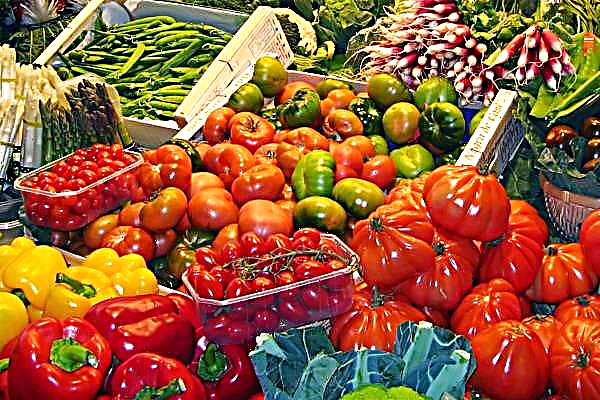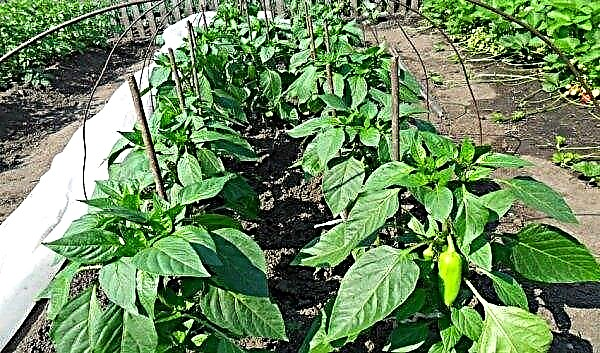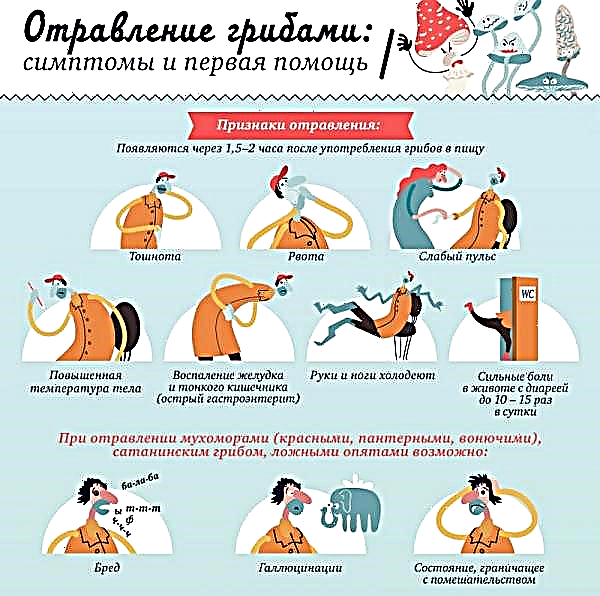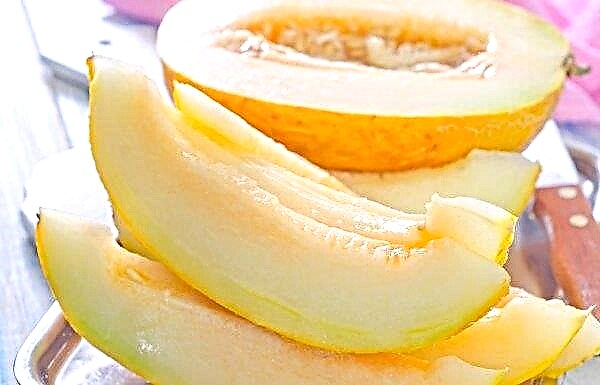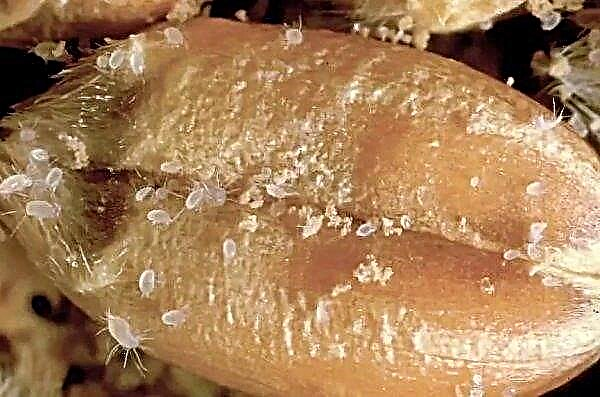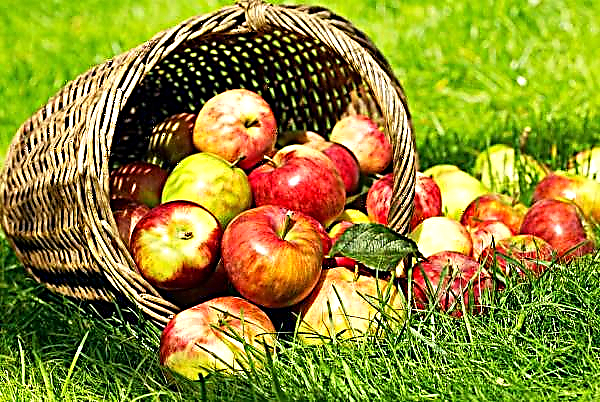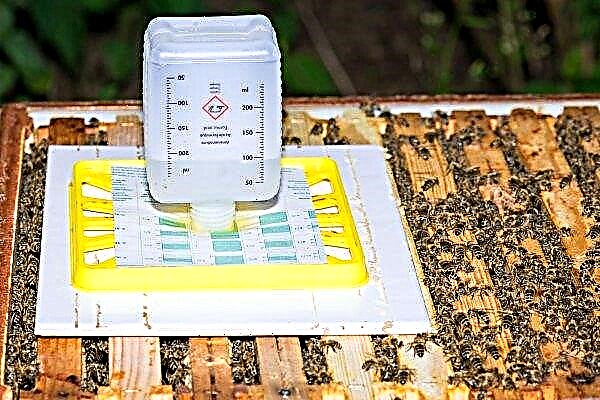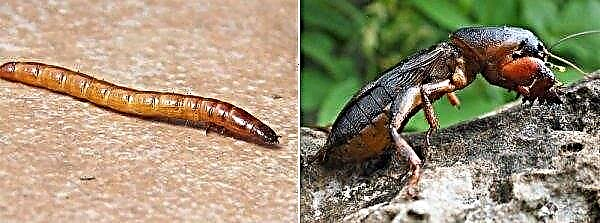Many city dwellers who buy milk exclusively in tetrapacks sincerely believe that cows produce this nutritious product throughout their lives. In fact, the process of lactation in the heifers is cyclical in nature and, like in humans, directly depends on the birth of the cub.
A common feature for all mammals are possible problems with the arrival of milk after childbirth. For lactation in a cow to be long and plentiful, a farmer needs to follow many rules, one of which is competent retention.
Did you know? It is estimated that the total surface of all alveoli in the udder of the heifer is more than one hundred square meters!
When to start milking a cow after calving
As a general rule, a cow should be milked one and a half to two hours after calving. However, before this, it is very important to restore the water and electrolyte balance in the animal’s body, as well as prevent possible postpartum infections, since how much milk will be produced by the hen depends on this condition largely.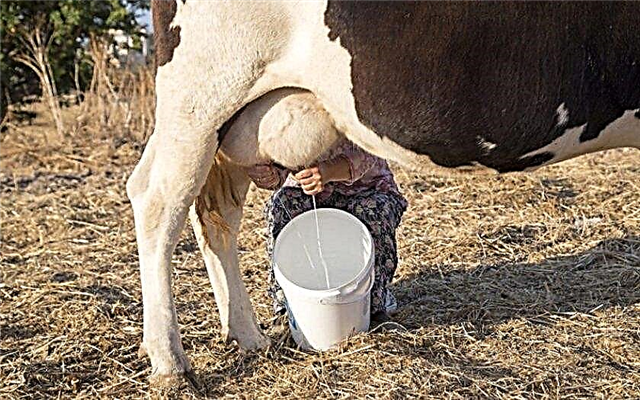 To do this, before the start of the first milking, very simple but necessary emergency measures should be carried out:
To do this, before the start of the first milking, very simple but necessary emergency measures should be carried out:
- Intensively rub the back of the animal’s body with a hard massage brush (you can use a homemade improvised tool, twisting dry hay or straw into a tight lump). This procedure will accelerate the contraction of the uterus, ensuring the outflow of blood from it.
- Gently wash the udder, vulva and surrounding skin with a disinfectant (you can use furatsilin or a weak solution of potassium permanganate) and wipe it dry with a soft cloth.
- Drink the animal with one and a half buckets of water heated to the temperature of the human body, in which first dilute 150-200 g of ordinary table salt (using another technology, sugar is added to the water at the rate of 0.5 kg per 10 l instead of salt).
Important! Amniotic fluid best helps restore water-salt metabolism and replenish the body with the necessary minerals. During calving, they should be collected and allowed to drink at least five liters to the animal.
Then the cow is fed with a small amount of fresh and high-quality hay, as well as, if desired, a liquid mixture of oats and bran or swill from steamed oatmeal. An hour after the animal has eaten, it can be milked. The described rules apply to the situation when the birth was successful, and the cows feel good. If the animal develops mastitis (the udder is swollen and hardened, this process usually manifests itself before calving), the cow should be extradited immediately after delivery, and you should try to free the udder completely.
If the animal develops mastitis (the udder is swollen and hardened, this process usually manifests itself before calving), the cow should be extradited immediately after delivery, and you should try to free the udder completely.
The resulting colostrum is destroyed, the calf cannot be given to avoid getting the baby or the infections that were used to treat the mother (both the bacteria that cause mastitis and antibiotics get into the milk and can cause serious disorders and even death of the calf).
Important! At least two months before the expected calving, milking the cow stops. This is necessary in order to allow the animal’s body to gather strength for full and abundant lactation, however, in addition, stimulation of the udder can provoke premature birth. The exception to this rule is precisely mastitis. When its symptoms appear, the animal must be milked both before calving and immediately after it.
For the same reason, babies are not allowed to cows with mastitis, although it is the calf that is able to develop the swollen udder as safely and intensively as possible. An even more serious complication after childbirth is paresis or, as it is also called, a coma of dairy cows. Cow paresis This disease has a nervous nature and is manifested by severe trembling in the extremities, staggering and even paralysis, accompanied by fainting. If the new-calf cow shows such signs or lies, characteristically arched neck, she needs urgent help.
Cow paresis This disease has a nervous nature and is manifested by severe trembling in the extremities, staggering and even paralysis, accompanied by fainting. If the new-calf cow shows such signs or lies, characteristically arched neck, she needs urgent help.
For this purpose, as a rule, a special technology of pumping air into the udder is used, which leads to the entry of the “correct” impulse into the brain. If the procedure has helped and the animal has steadily risen to its feet, they begin to milk it after two hours. Otherwise, treatment is continued.
Why massage the udder
The process of secretion and accumulation of milk in a cow takes place in the so-called alveoli - tiny cavities, from which the nutrient mixture then passes through special ducts into milk tanks, and from them into the nipple. This movement does not occur in the form of free current, but under the pressure provided by the contractions of the muscle cells surrounding the alveoli.
The “team” for alveolar contraction is given by the brain in response to stimulating the udder (in natural conditions, when the calf begins to suck it) by producing a special hormone, oxytocin, secreted by the pituitary gland.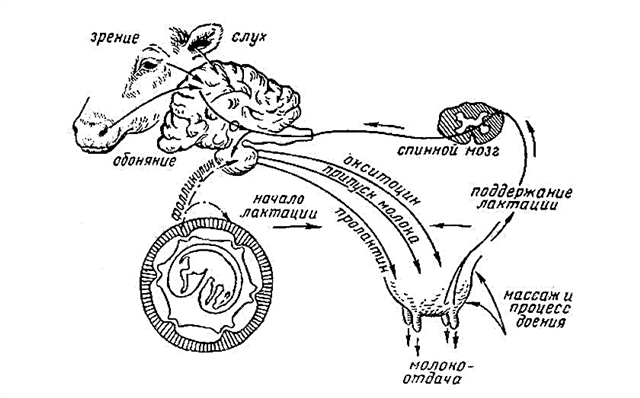 The process of milk secretion Before milking, half of the milk produced is already in the milk ducts and tanks and is ready to stand out at the slightest touch, but at least as much remains in the alveoli. To extract this very second half, it is necessary to stimulate the production of oxytocin. It is known that from the first touch of the udder to the start of milk flow from the alveoli into the milk ducts, approximately 45-60 seconds pass.
The process of milk secretion Before milking, half of the milk produced is already in the milk ducts and tanks and is ready to stand out at the slightest touch, but at least as much remains in the alveoli. To extract this very second half, it is necessary to stimulate the production of oxytocin. It is known that from the first touch of the udder to the start of milk flow from the alveoli into the milk ducts, approximately 45-60 seconds pass.
If the milking process is not organized correctly, then after the cessation of cistern milk is milked, the milking process for some time passes “idle” until the fluid from the alveoli enters the nipple. Such a break is very harmful to the health of the animal and, in addition, leads to significant losses in productivity, sometimes up to 30-40%.
Stimulation of the udder by gentle massage provides a uniform and continuous milking when milk from milk tanks smoothly changes to alveolar. Massage of the udder in a newborn cow is also the best prevention of edema and mastitis. However, so that the animal does not get nervous, the procedure should be started before calving. Massage of the udder of a cow First of all, this refers to first-calf heifers, for whom stimulation of the udder causes new and incomprehensible sensations. A few days before the expected start of labor, massage should be discontinued, as it, like a full milking, can cause childbirth earlier than expected.
Massage of the udder of a cow First of all, this refers to first-calf heifers, for whom stimulation of the udder causes new and incomprehensible sensations. A few days before the expected start of labor, massage should be discontinued, as it, like a full milking, can cause childbirth earlier than expected.
To avoid spasm of blood vessels and emotional stress, you need to touch the udder only with warm hands. The procedure is carried out very carefully and does not last long, no more than thirty seconds. It consists in gently stroking first the right and then the left half of the udder with active, but at the same time, non-coarse movements.
Important! When performing the massage, both the udder and the hands of the person performing the procedure should be perfectly clean and dry.
How to milk a cow after calving
The special term "breeding", used by livestock breeders, means the formation of a lactation process in a calving cow. Subsequent productivity directly depends on how correctly it is carried out. It is important to know that these events begin not after calving, but at least two months before it. During this period it is necessary:
During this period it is necessary:
- provide the animal with additional nutrition according to special schemes, so that the cow does not spend internal reserves on bearing the fetus, but receives everything necessary with food;
- heifers should begin to accustom to the process of milking with a light massage, completely stop milking of adult cows.
If all the necessary conditions for the burenka are created, the birth of the calf should pass without complications and, therefore, you can proceed to undress.
Important! The milking process usually takes from ten to fifty days after calving, if everything is organized correctly, it is followed by a cycle of the highest milkings lasting up to ten months.
In order for lactation to establish quickly and be as productive as possible, during the milking period it is necessary:
- provide the animal with the so-called advanced (enhanced) nutrition, while carefully monitoring that the heifers do not gain excess weight;
- closely monitor the condition of the udder, especially during the first days after calving, to prevent swelling, stagnation of milk, hardening;
- keep animals warm and protect from drafts;
- pay special attention to the cleanliness of the litter - the main source of dirt and germs on the udder;
- very strictly observe the milking regimen, combining it with massage in the first days (observing the regimen of the day as a whole is equally important);
- give the cow as much fluid as possible, because without it milk production is physically difficult.

However, the last rule requires special reservation. The fact is that in first-calf heifers, as well as in animals of highly productive breeds, the udder often swells after calving, and this can lead to the development of various pathologies. In this case, the first five days are a critical period, then swelling gradually subsides.
In order to alleviate the condition of the animal, the amount of fluid consumed by it should be reduced, and this applies not only to drinking as such, but also to succulent feed. But massage, on the contrary, should be done more often, moving along the blood and lymph flow - from the nipple to the base of the udder.
If such procedures do not help, you can use emollient or absorbable ointments, but it is important to know that some of them are categorically contraindicated during the milking period, so a preliminary consultation with the veterinarian must be done.
Did you know? Farmers argue that proper milking increases milk production by 20–40%.
Of particular importance is the observance of the dosing regime in primogenous heifers. In general, it is carried out according to the same rules that apply to adult animals, but requires more attention and thoroughness. Therefore, in large farms, recently calving young stocks are usually placed separately from the main herd for at least three months. Here, with regard to animals, the following events are held:
Here, with regard to animals, the following events are held:
- during the first two to three weeks, they feed the heifers in a slightly limited volume so as not to provoke swelling of the udder, mastitis, upset gastrointestinal tract or other postpartum problems;
- only after it becomes obvious that the animal has recovered after childbirth, do they begin to intensify feeding using compound feeds and root crops;
- supplemental nutrition is introduced gradually, as milk yield increases, and stops when stable lactation is established;
- 10 days after the start of receiving fixed milk yield, the daily portion of food is also gradually reduced to the normal norm;
- every 10 days during the entire milking period, control milking is carried out in order to check the amount of fats and proteins in milk;
- if free grazing is not possible, heifers must be fed green feed;
- at the end of the milking process, the productivity of each cow is evaluated according to a certain set of indicators (the amount of milk per day and for a period, the speed of its delivery, the state of the udder, etc.) and decide on its future use.

How many times do you need to milk a cow
The frequency and regularity of milkings is no less important for good lactation than proper care and nutrition.
Important! There is a direct and inextricable link between feeding and milking. If a cow does not receive enough nutrients, her body cannot produce milk at full strength, but the opposite rule works the same way: a plentiful diet increases lactation only if the udder is completely and regularly emptied, otherwise the excess feed will only be reflected on an increase in animal weight.
The first seven days after calving, the cows are usually milked four to five times a day with a four to five hour break. For example, the first milking can be carried out at 5.00, the last - at 20.00, and between them milk the cow another 2-3 times. The break between milking (at night) should not be longer than ten hours, so that the milk does not have time to stagnate.
For maximum productivity, it is very important that the udder is emptied at the same hours, and the breaks between milking are of the same duration. First heifers are associated with particularly unstable milk production, so it is recommended to additionally empty the udder (make a pod) one and a half hours after each milking, reducing their number to four per day. It is strongly recommended that you use milking machines for pods, rather than manually. If the animal showed signs of paresis after childbirth, the first day or two should not be extradited until the remainder. This rule is also recommended for preventive purposes. Do not rush to reduce the number of daily milking, especially in relation to highly productive individuals.
It is strongly recommended that you use milking machines for pods, rather than manually. If the animal showed signs of paresis after childbirth, the first day or two should not be extradited until the remainder. This rule is also recommended for preventive purposes. Do not rush to reduce the number of daily milking, especially in relation to highly productive individuals.
Excessive milk production in the udder leads to stagnation, roughness of the nipples due to leakage of fluid and, as a result, their inflammation. The signal for the transition to a three-time milking should be a stabilized lactation process (not earlier than a week after calving), and by the time the average daily amount of milk is reduced to 10 liters, it is enough to carry out the procedure twice - in the morning and evening.
Important! The udder of a cow consists of two parts that are not communicated with each other. Milking should always start from the back and only then go to the front.
At the milking stage, it is also very important not to injure the udder by pinching it with your fingers. With manual milking, you can only work with your whole hand. The machine method, from this point of view, is safer, but if the udder is swollen, it should not be used.
Proper Care and Feeding
Caring for a cow after calving means proper nutrition, hygiene and regular milking. For the quick recovery and prevention of the development of various infectious diseases, the cows must be allowed to lick the newborn calf. It is in the mucus that covers the baby, contains specific hormones that are responsible for the formation of lactation and stimulate metabolic processes in the mother's body. The first feeding should be carried out no later than half an hour after birth.
The rest of the feeding is carried out according to the following scheme:
| Days after calving | Daily ration |
| The first | warm liquid mash from wheat bran or oatmeal (1/2 kg per 10 liters of water); fresh hay of high quality - 3-5 kg or green feed (meadow grass) - 8-10 kg |
| Second | hay or grass in the same amount, the rate of bran or oatmeal in the talker is doubled |
| Third fourth | a mixture of flaxseed meal, bran and oats - 1.5 kg; root crops (beets are better) - 2-4 kg; concentrated feed - 1 kg |
| Fifth - Sixth | norm of the previous day with an increase in feed by 0.5 kg per day (up to 2 kg) |
| Seventh - Tenth | the norm of the previous day with an increase in feed by 0.4 kg per day and the gradual addition of silage, pumpkin and other succulent feeds |
The amount of grain needed for a dairy cow during the day is determined depending on two factors - the weight of the animal and the level of milk yield. For example, a heifer weighing 400 kg must:
For example, a heifer weighing 400 kg must:
- with 8 kg milk yield - 8 kg of average quality or its equivalent (the so-called feed unit);
- with milk yield of 12 kg - 10 kg of oats;
- with milk yield of 20 kg - 14 kg of oats.
Did you know? A cow's udder can hold more than twenty-five liters of milk!
When forming the diet of a cow during milking, the following rules should also be considered:
- First-calf animals should receive more feed than adults.
- Active and motile animals need more high-calorie foods than phlegmatic individuals.
- In direct access, the heifers should have a sufficient amount of clean and slightly warm water.
- Small weight loss during the month after birth is the norm, but in the future - the weight of the animal should be fully stabilized.
- If the cow continues to lose weight and at the same time gives stable milk yields, the nutritional value of the daily diet should be increased, since this situation indicates that the animal’s body uses internal reserves for milk production (“the cow gives up from the body”).
- Weight gain beyond the previously available is not only the loss of farmer's funds, but also the path to obesity of the animal, which should not be allowed.

When you can drink milk after calving
During the first five days after calving, the cow does not produce milk, but colostrum. It has low fat content, but is rich in antibodies designed to maintain the immune barrier of the newborn. However, the inhabitants of many Russian villages traditionally ignore this rule, considering its specific taste to be the only obstacle to the consumption of colostrum.
Important! Theoretically, colostrum is edible, but it should not be consumed: it is intended for the calf and is definitely more necessary for it.
Why does a cow not give milk
This problem is often encountered by novice farmers and owners of small households. There may be several reasons for the absence or insufficient amount of milk, as a rule, they all come down to improper care of the animal before and after calving.
Following all the above recommendations, the lactation process can be established, however, if you still can’t do this, you should also pay attention to other factors that could affect the production of milk. Let's try to highlight the most characteristic of them.
| The reason for the lack of milk in the cow | Possible solutions |
| The animal does not want to give milk, instinctively leaving it for the calf | The calf should not be allowed to the udder, but should be milked from the bottle with milk. At the same time, it is recommended to keep the baby separately from the mother, then the animal quickly forgets about parental feelings. |
| Milk is too fat, and therefore its outflow is difficult | During milking, a cow must not be overfed or given an excess amount of high-calorie food. |
| The milk ducts are narrowed | This symptom may indicate adrenal disease and increased adrenaline production. But everything can be explained more simply, for example, by the shock that the first-calf experienced from touching her udder with cold hands or from injuring him with inept movements. |
| Mastitis, edema and other diseases of the udder | Caused by improper care, hypothermia, injuries, infections. They require timely diagnosis and proper treatment. |
| Emotional stress | Like humans, lactation in animals is largely dependent on the emotional state. An experienced fright can easily lead to a blockage in the synthesis of oxytocin and, as a result, to the loss of milk. |
| General disease | There are many diseases that adversely affect the production of milk, so it is very important to carefully monitor the animal’s health and recognize the characteristic symptoms of the disease in time. |
| Late launch and other disorders of the lactation cycle | Excessive exploitation inevitably leads not only to a decrease in milk yield, but also to a reduction in the life expectancy of the herd. |
| Individual features of the structure of the nipple muscles and hereditary factor | Not all animals are equally productive, even the breed is not a guarantee of high milk yield. |
Did you know? The biggest annoyance in the world remains the result recorded in 1941 in Russia. During the day, a cow named Vienna “gave out” 82.15 liters of milk.
Distributing cows after calving is a very important stage in dairy farming. Here, as in the process of growing crops, a general rule applies: what you sow, you will reap. It is necessary to start preparing a heifer for lactation during pregnancy (pregnancy), and the process can be considered completed only when the average daily milk yield is fully stabilized, the animal does not lose weight and feels good.

